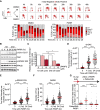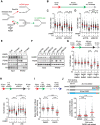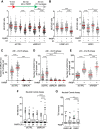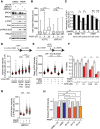The trans cell cycle effects of PARP inhibitors underlie their selectivity toward BRCA1/2-deficient cells
- PMID: 34385259
- PMCID: PMC8415318
- DOI: 10.1101/gad.348479.121
The trans cell cycle effects of PARP inhibitors underlie their selectivity toward BRCA1/2-deficient cells
Abstract
PARP inhibitor (PARPi) is widely used to treat BRCA1/2-deficient tumors, but why PARPi is more effective than other DNA-damaging drugs is unclear. Here, we show that PARPi generates DNA double-strand breaks (DSBs) predominantly in a trans cell cycle manner. During the first S phase after PARPi exposure, PARPi induces single-stranded DNA (ssDNA) gaps behind DNA replication forks. By trapping PARP on DNA, PARPi prevents the completion of gap repair until the next S phase, leading to collisions of replication forks with ssDNA gaps and a surge of DSBs. In the second S phase, BRCA1/2-deficient cells are unable to suppress origin firing through ATR, resulting in continuous DNA synthesis and more DSBs. Furthermore, BRCA1/2-deficient cells cannot recruit RAD51 to repair collapsed forks. Thus, PARPi induces DSBs progressively through trans cell cycle ssDNA gaps, and BRCA1/2-deficient cells fail to slow down and repair DSBs over multiple cell cycles, explaining the unique efficacy of PARPi in BRCA1/2-deficient cells.
Keywords: BRCA; DNA damage; PARP inhibitor; cell cycle; replication.
© 2021 Simoneau et al.; Published by Cold Spring Harbor Laboratory Press.
Figures







Similar articles
-
Gap resection matters in BRCA mutant cancer.Genes Dev. 2025 May 2;39(9-10):539-540. doi: 10.1101/gad.352827.125. Genes Dev. 2025. PMID: 40210436 Free PMC article. Review.
-
ATR inhibition disrupts rewired homologous recombination and fork protection pathways in PARP inhibitor-resistant BRCA-deficient cancer cells.Genes Dev. 2017 Feb 1;31(3):318-332. doi: 10.1101/gad.290957.116. Epub 2017 Feb 27. Genes Dev. 2017. PMID: 28242626 Free PMC article.
-
Replication gaps are a key determinant of PARP inhibitor synthetic lethality with BRCA deficiency.Mol Cell. 2021 Aug 5;81(15):3128-3144.e7. doi: 10.1016/j.molcel.2021.06.011. Epub 2021 Jul 2. Mol Cell. 2021. PMID: 34216544 Free PMC article.
-
Exploiting replication gaps for cancer therapy.Mol Cell. 2022 Jul 7;82(13):2363-2369. doi: 10.1016/j.molcel.2022.04.023. Epub 2022 May 13. Mol Cell. 2022. PMID: 35568026 Free PMC article. Review.
-
Schlafen 11 further sensitizes BRCA-deficient cells to PARP inhibitors through single-strand DNA gap accumulation behind replication forks.Oncogene. 2024 Aug;43(32):2475-2489. doi: 10.1038/s41388-024-03094-1. Epub 2024 Jul 3. Oncogene. 2024. PMID: 38961202 Free PMC article.
Cited by
-
Reversing regulatory safeguards: Targeting the ATR pathway to overcome PARP inhibitor resistance.Mol Ther Oncol. 2025 Jan 14;33(1):200934. doi: 10.1016/j.omton.2025.200934. eCollection 2025 Mar 20. Mol Ther Oncol. 2025. PMID: 39968096 Free PMC article. Review.
-
Lagging strand gap suppression connects BRCA-mediated fork protection to nucleosome assembly through PCNA-dependent CAF-1 recycling.Nat Commun. 2022 Sep 9;13(1):5323. doi: 10.1038/s41467-022-33028-y. Nat Commun. 2022. PMID: 36085347 Free PMC article.
-
Loss of MED12 activates the TGFβ pathway to promote chemoresistance and replication fork stability in BRCA-deficient cells.Nucleic Acids Res. 2021 Dec 16;49(22):12855-12869. doi: 10.1093/nar/gkab1184. Nucleic Acids Res. 2021. PMID: 34871431 Free PMC article.
-
Role of Translesion DNA Synthesis in the Metabolism of Replication-associated Nascent Strand Gaps.J Mol Biol. 2024 Jan 1;436(1):168275. doi: 10.1016/j.jmb.2023.168275. Epub 2023 Sep 13. J Mol Biol. 2024. PMID: 37714300 Free PMC article. Review.
-
The Role of PARP Inhibitors in Patients with Primary Malignant Central Nervous System Tumors.Curr Treat Options Oncol. 2022 Nov;23(11):1566-1589. doi: 10.1007/s11864-022-01024-5. Epub 2022 Oct 15. Curr Treat Options Oncol. 2022. PMID: 36242713 Free PMC article. Review.
References
-
- Berti M, Ray Chaudhuri A, Thangavel S, Gomathinayagam S, Kenig S, Vujanovic M, Odreman F, Glatter T, Graziano S, Mendoza-Maldonado R, et al.2013. Human RECQ1 promotes restart of replication forks reversed by DNA topoisomerase I inhibition. Nat Struct Mol Biol 20: 347–354. 10.1038/nsmb.2501 - DOI - PMC - PubMed
Publication types
MeSH terms
Substances
Grants and funding
LinkOut - more resources
Full Text Sources
Research Materials
Miscellaneous
